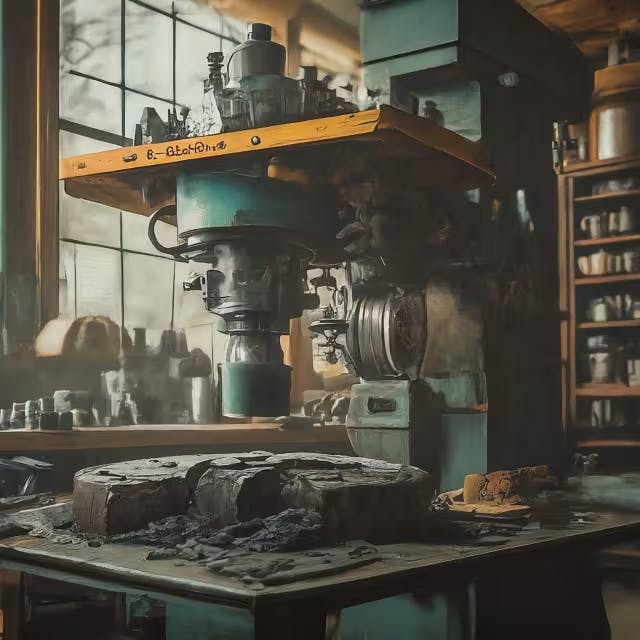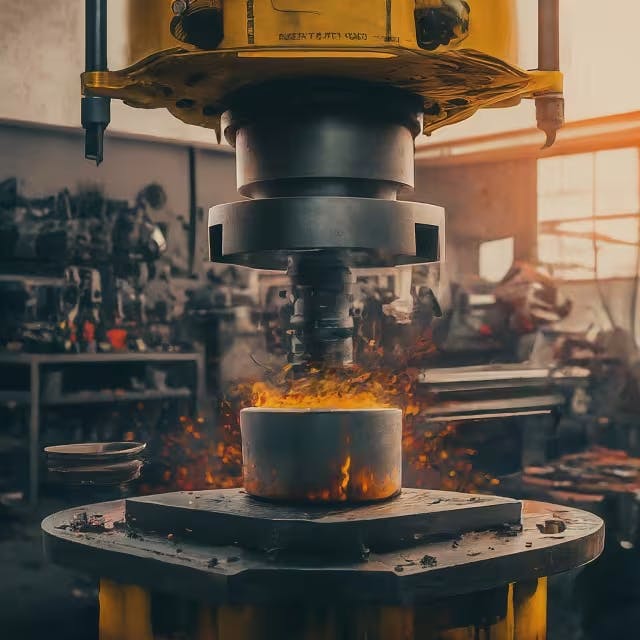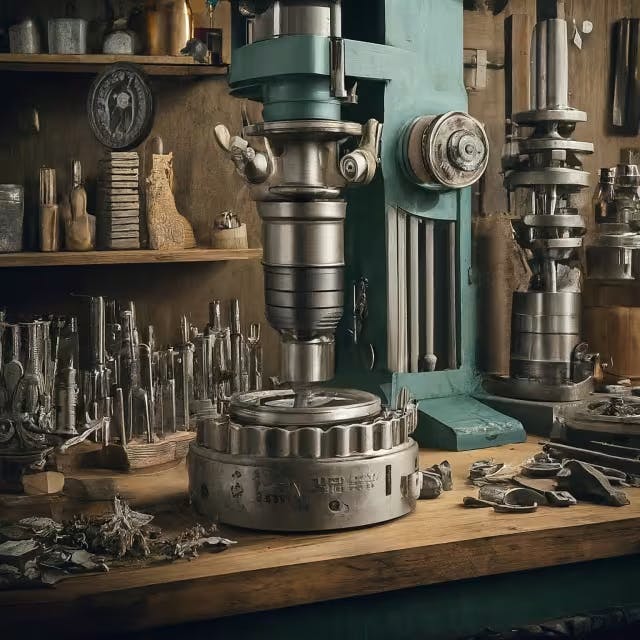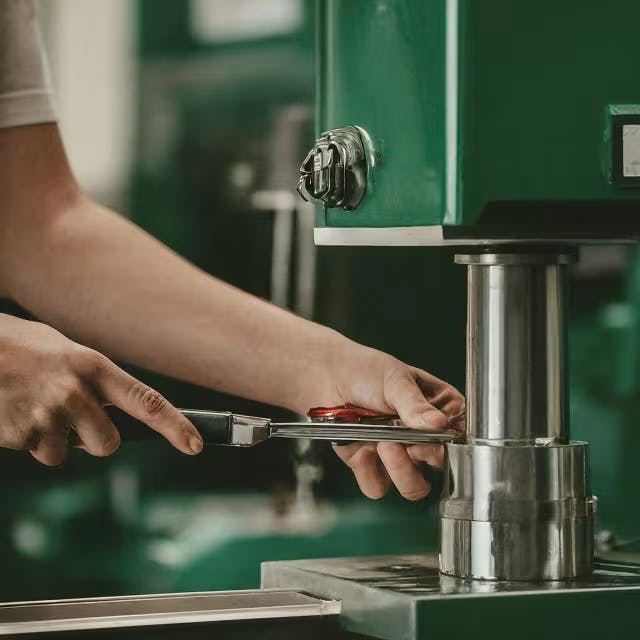Fly Press Tooling: Maximizing Versatility
Abana Chapter
March 09, 2024

Discover the world of Fly Press Tooling, a crucial aspect that lies at the heart of maximizing versatility in metal forming techniques. With the evolving landscape of metal bending, which encompasses both traditional and innovative approaches like bottom bending and air bending, the quest for precision and efficiency has never been more critical. This article dives into how Fly Press Tooling is pivotal in meeting these industrial challenges, offering insights into its benefits, varieties, selection process, and practical tips to harness its full potential for your projects.
Key Takeaways
Fly Press Tooling is essential for achieving high precision and efficiency in metal forming, accommodating both traditional and innovative techniques.
The versatility offered by Fly Presses significantly enhances the capability of metal forming processes, enabling a wide range of operations from bottom bending to air bending.
Various types of Fly Press Tooling are available, catering to different requirements and applications in the metal forming industry.
Selecting the right Fly Press Tooling is crucial for optimizing project outcomes, and involves considering factors such as material type, thickness, and specific project needs.
Employing specific tips and tricks can greatly improve the effectiveness and longevity of Fly Press Tooling, maximizing the potential of metal forming projects.
Understanding the basics and benefits of Fly Press Tooling is fundamental for professionals in the metal forming sector to leverage its full capability in their operations.

Understanding the Basics of Fly Press Tooling
Fly press tooling is a cornerstone of metalworking, allowing craftsmen to shape, form, and cut materials with precision and versatility. At its core, fly press tooling consists of a heavy, vertically mounted screw that exerts force when manually driven by a weighted arm or wheel. This setup enables the application of significant force, making it suitable for a variety of tasks from punching holes to bending metal.
The true magic of fly press tooling lies in its adaptability. By swapping out dies and tooling, one can perform an impressive array of metalworking techniques. This includes everything from simple operations like cutting and shaping to more complex processes such as coining and forming intricate patterns.
For those diving into the specifics, understanding the relationship between the fly press, swage blocks, and swage tools is pivotal. As highlighted in a comprehensive guide on swage blocks and swage tools, these tools complement the fly press by offering additional precision and versatility. Swage blocks, in particular, are used alongside the fly press for bending, shaping, and punching metals, enabling artisans to achieve dimensions and shapes that would be challenging to accomplish otherwise.
Selecting the right tooling for your fly press can significantly enhance its capability. Consider the following key aspects when choosing tooling:
Material: Ensure the tooling material can withstand the force applied by the fly press without deforming.
Compatibility: Check that the tooling fits securely and precisely in the fly press to avoid accidents or damage.
Purpose: Select tooling designed specifically for the task at hand, whether it's cutting, shaping, or forming metal.
Embracing the versatility of fly press tooling opens up a world of creative possibilities. Whether you're a seasoned professional or a hobbyist, mastering the fly press and its associated tooling can elevate your metalworking projects to new heights. For further insights into the application of swage blocks in metalworking, consider exploring the versatility and multiple uses of swage blocks.

The Benefits of Versatility in Metal Forming with Fly Presses
Fly press tooling, when executed with skill and the right equipment, can elevate the craft of metal forming to new heights of precision and efficiency. Advances in metal bending techniques, particularly the integration of air bending, have paved the way for greater versatility in manufacturing processes. Unlike traditional bottom bending, which can be restrictive due to its need for constant tool changes, air bending allows for a more flexible approach. This method requires less tonnage, promoting efficiency and reducing operational costs. Additionally, with the latest advancements in technology, the challenges of achieving consistent angles due to material variations are being addressed. Modern press brakes now incorporate in-process angle measurement and correction technologies, ensuring that the efficiency of air bending does not compromise the accuracy of the finished product. Discover more about these metal forming techniques and how they enhance fly press tooling's versatility in the latest industry insights.
Incorporating a fly press into your toolkit opens up a world of possibilities. Whether you're crafting intricate jewelry or constructing robust architectural elements, the nuanced control offered by a fly press is unparalleled. For those looking to delve deeper into the capabilities and techniques of fly press tooling, exploring resources on anvil hardy tools and swages and fullers can provide valuable insights. These tools further expand the versatility of metal forming, enabling artisans and fabricators to achieve precision results with less effort and time.

Exploring the Various Types of Fly Press Tooling
Variety is the spice of life, and when it comes to fly press tooling, this couldn’t be truer. This type of equipment is key in the manufacturing and metalworking world, offering precision and versatility that's truly unmatched. Let's take a closer look at the different types of tooling available for a fly press, each designed to meet specific needs and challenges.
First up, we have blanking tools. These are perfect for when you need to cut out parts from sheets of metal with precision. They come in various shapes and sizes, ensuring that no matter the project, there’s a tool for the job. For those needing to create holes or cutouts within materials, punching tools step into the spotlight. These tools can be customized to punch through metal with incredible accuracy.
Forming tools bring a bit of shape and contour to the mix. They allow materials to be bent or shaped into specific forms, essential for creating components with complex geometries. And let’s not forget threading tools, which are indispensable for adding threads to holes, enabling screws or bolts to be fitted securely.
Each tool brings something unique to the table, and understanding their capabilities can significantly enhance productivity and innovation in metalworking projects. For those delving deeper into the realm of advanced metalworking tools and how they revolutionize efficiency, checking out discussions on CNC machines, laser cutters, and more can offer further insights into cutting-edge equipment and its impact on the industry.

How to Select the Right Fly Press Tooling for Your Project
Selecting the appropriate fly press tooling can truly transform your project's outcome. It's akin to choosing the right ingredients for a recipe—each tool brings its unique flavor to the final product. Here are some tips to help guide you through this pivotal choice:
Understand your project needs: Before diving into purchases, clearly outline what you're trying to achieve. Different tasks require specific tooling options.
Material compatibility: Ensure the tools you select can handle the type of material you're working with without causing damage or wear.
Precision is key: For projects requiring intricate detail, opting for tooling that offers precise control can make all the difference. This might mean investing a bit more, but the quality of your work will speak volumes.
Explore versatility: Some tools are designed to perform multiple functions. This can be a cost-effective way to expand your capabilities without needing a vast collection of specialized tooling.
For those interested in honing their metalworking skills, exploring resources on crafting essentials like high-quality rounding hammers can offer some foundational knowledge. Similarly, understanding the pivotal role of quality anvils in your craftsmanship can aid in making informed decisions when it comes to tool selection.
In the world of metalworking, being equipped with the right tools is half the battle. Take your time to research and select the fly press tooling that not only meets your current needs but also allows room for creativity and expansion.

Tips and Tricks for Getting the Most Out of Your Fly Press Tooling
When diving into projects that demand exacting metalworking skills, it's essential to appreciate the role that fly press tooling can play in your workshop. Getting the most out of this powerful equipment requires not only technical prowess but also the appropriate accessories and methods. By delving into the various tooling options available, such as specialty punches and drifts, you can significantly broaden what you're able to achieve with your fly press.
Take, for example, the need to work with delicate materials or execute complex designs. By bringing specific tools into play, like the Tom Clark Style Punch Set, you can markedly improve your results. This set presents not only the accuracy required for intricate jewelry tasks but also the resilience necessary for heavier-duty work in automotive contexts.
Further enhancing the versatility of your fly press involves incorporating a range of tongs designed for different purposes. Whether you're dealing with small, fragile pieces using precision duckbill tongs or handling larger, unwieldy materials with robust wolf jaw tongs, having the right tongs is crucial for ensuring both safety and precision.
Participating in discussions and seeking insights from those who have extensive experience can also prove to be incredibly beneficial. A recent exchange on the Ganoksin’s Orchid forum highlighted the practicalities involved in transporting and installing a heavy fly press. Contributors shared their experiences and strategies, such as the need for a team of two to four people to move the press safely and the importance of a sturdy foundation to support its significant weight. This conversation shows that peer advice can be just as critical as the right tooling Ganoksin Discussion.
It all boils down to more than just having the appropriate tools at your disposal. Truly capitalizing on the capabilities of your fly press means understanding how to integrate these tools seamlessly into your metalworking practices. By striking the right balance between expertise, knowledge, and suitable tooling, you can unlock the full potential of your fly press, propelling your metalworking projects to new heights of efficiency and versatility. Equipping yourself with knowledge about fly press tooling and leveraging its full potential can significantly enhance the precision and versatility of your metalworking projects. By selecting the right tooling for your specific needs and mastering associated techniques, you unlock an array of possibilities for shaping and forming metal. Embracing the advances in metal forming and incorporating comprehensive resources will ensure your projects benefit from the utmost efficiency and accuracy.
Frequently Asked Questions
What is fly press tooling and how does it enhance metalworking versatility?
A fly press tool is a versatile piece of equipment used in metalworking for shaping, forming, and cutting materials with high precision. It employs a heavy, vertically mounted screw driven by a weighted arm, allowing it to exert substantial force for a variety of tasks. The tooling for the fly press can be changed to perform diverse techniques, such as punching holes, bending metal, and forming intricate patterns, significantly enhancing its utility in metalworking projects.
How do swage blocks and tools complement fly press tooling?
Swage blocks and tools enhance fly press tooling by offering additional precision and versatility essential for metalworking tasks such as bending, shaping, and punching. They enable craftsmen to achieve specific dimensions and shapes that might be challenging with the fly press alone. By complementing the fly press's capability to apply significant force with the refined functions of swage blocks and tools, artisans can execute a wider range of techniques and work with a broader spectrum of materials, thus elevating the level of detail and complexity in their projects.
What are the key considerations when selecting tooling for your fly press?
Choosing the right fly press tooling involves considering the material and compatibility to ensure it withstands force without deforming and fits securely. Look for tooling designed for your specific task, whether cutting, shaping, or forming metal. Embrace the versatility by selecting multi-functional tools for a cost-effective way to expand capabilities, ensuring precision and compatibility with the material.
How do advances in metal bending techniques impact the efficiency of fly press tooling?
Advances in metal bending techniques, specifically the development of air bending processes and the integration of technology for angle measurement and correction, significantly enhance the efficiency of fly press tooling. These advancements allow for more versatile and efficient manufacturing processes by reducing tonnage requirements and operational costs while ensuring high precision. Consequently, modern fly press tooling can achieve a wider range of tasks with greater accuracy and lower efforts, transforming the capabilities of metalworking projects.
What types of fly press tooling are available and how do they meet specific project needs?
Fly press tooling caters to a wide array of metalworking needs, with different types designed for specific tasks: blanking tools for precise cutting, punching tools for creating holes or cutouts, forming tools for bending or shaping, and threading tools for adding threads. Each tooling type enhances productivity and innovation in projects, ensuring compatibility with various materials and allowing for precision work. Selecting the right tools based on project requirements, material compatibility, and desired precision can significantly impact the quality and efficiency of metalworking endeavors.
How can one ensure they are choosing the right fly press tooling for their metalworking projects?
Choosing the right fly press tooling involves understanding your project's requirements and ensuring tool compatibility and durability. Consider tooling made from materials that can withstand the force of your fly press and are precisely designed for tasks like cutting, shaping, or forming metal. Exploring tooling options that offer versatility for different metalworking techniques can enhance your project's efficiency and outcome.


